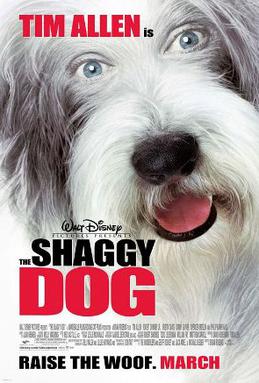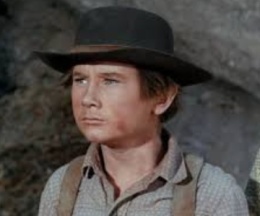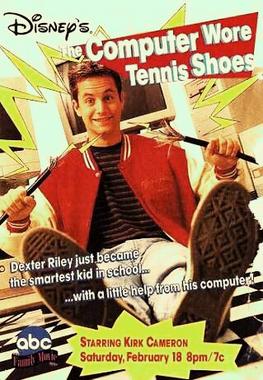
The Shaggy Dog is a 1959 American fantasy comedy film produced by Walt Disney Productions and loosely based on the 1923 novel The Hound of Florence by Felix Salten. Directed by Charles Barton from a screenplay by Lillie Hayward and Bill Walsh, the film stars Fred MacMurray, Tommy Kirk, Jean Hagen, Kevin Corcoran, Tim Considine, Roberta Shore, and Annette Funicello. The film follows a teenage boy named Wilby Daniels who, by the power of an enchanted ring of the Borgias, is transformed into a shaggy Old English Sheepdog.

Thomas Lee Kirk was an American actor, best known for his performances in films made by Walt Disney Studios such as Old Yeller, The Shaggy Dog, Swiss Family Robinson, The Absent-Minded Professor, and The Misadventures of Merlin Jones, as well as the beach-party films of the mid-1960s. He frequently appeared as a love interest for Annette Funicello or as part of a family with Kevin Corcoran as his younger brother and Fred MacMurray as his father.
(The) shaggy dog may refer to:

Robert Edward Stevenson was a British-American screenwriter and film director.
William Crozier Walsh was a film producer, screenwriter and comics writer who primarily worked on live-action films for Walt Disney Productions. He was born in New York City. For his work on Mary Poppins, he shared Academy Award nominations for Best Picture with Walt Disney, and for Best Writing, Screenplay Based on Material from Another Medium with Don DaGradi. He also wrote the Mickey Mouse comic strip for more than two decades.

The Absent-Minded Professor is a 1961 American science fiction comedy film directed by Robert Stevenson and produced by Walt Disney Productions. It is based on the 1943 short story "A Situation of Gravity" by Samuel W. Taylor. The title character was based in part on Hubert Alyea, a professor emeritus of chemistry at Princeton University, who was known as "Dr. Boom" for his explosive demonstrations. The film stars Fred MacMurray as Professor Ned Brainard, alongside Nancy Olson, Keenan Wynn, Tommy Kirk, Leon Ames, Elliott Reid, and Edward Andrews. The plot follows Brainard as he invents a substance that defies gravity, which he later exploits through various means.

The Shaggy Dog is a 2006 American science fantasy family comedy film directed by Brian Robbins and written by The Wibberleys, Geoff Rodkey, Jack Amiel, and Michael Begler. It is the fifth overall installment of the titular franchise, and is a reboot of the 1959 film of the same name and its 1976 sequel The Shaggy D.A., both of which were loosely based on the 1923 novel The Hound of Florence by Felix Salten. The original film had a character named Wilby Daniels transforming into an Old English Sheepdog after putting on a magic ring, whereas the remake presents a character named Dave Douglas transforming into a Bearded Collie after getting bitten by a sacred dog. It stars Tim Allen, Robert Downey Jr., Kristin Davis, Danny Glover, Spencer Breslin, Jane Curtin, Zena Grey and Philip Baker Hall.

Norman Tokar was an American director, actor and occasionally writer and producer of serial television and feature films, who directed many of the early episodes of Leave it to Beaver, and found his greatest success directing over a dozen films for Walt Disney Productions, spanning the 1950s to the 1970s.

The Ugly Dachshund is a 1966 American comedy film directed by Norman Tokar, written by Albert Aley, and starring Dean Jones and Suzanne Pleshette in a story about a Great Dane who believes he is a dachshund. Produced by Walt Disney Productions, the film was based on a 1938 novel by Gladys Bronwyn Stern. It was one of several light-hearted comedies produced by the Disney Studios during the 1960s. The animated featurette Winnie the Pooh and the Honey Tree directed by Wolfgang Reitherman, was attached to the film in theatrical showings.

The Computer Wore Tennis Shoes is a 1969 American science fiction comedy film starring Kurt Russell, Cesar Romero, Joe Flynn and William Schallert. It was produced by Walt Disney Productions and distributed by Buena Vista Distribution Company.

Kevin Anthony "Moochie" Corcoran was an American child actor, director and producer. He appeared in numerous Disney projects between 1957 and 1963, leading him to be honored as a Disney Legend in 2006. His nickname, Moochie, established him as an irrepressible character in film.

The Computer Wore Tennis Shoes is a 1995 American made-for-television science fiction comedy film directed by Peyton Reed and written by Joseph L. McEveety and Ryan Rowe. The film is a remake of the 1969 film of the same name. It premiered on ABC as an ABC Family Movie on February 18, 1995. It is the second in a series of four remakes of Disney live-action films produced for broadcast on the network during the 1994–95 television season, the other three being The Shaggy Dog, Escape to Witch Mountain, and Freaky Friday.

Son of Flubber is a 1963 American science fiction comedy film directed by Robert Stevenson and produced by Walt Disney Productions. It is the sequel to The Absent-Minded Professor (1961) and the first sequel to a Disney film. Fred MacMurray reprises his role from the previous film as Ned Brainard, a scientist who has perfected a high-bouncing substance, Flubber, that can levitate an automobile and cause athletes to bounce into the sky. In addition to MacMurray, Nancy Olson, Keenan Wynn, Ed Wynn, Elliott Reid, and Tommy Kirk also co-star, reprising their roles from the previous film.

The Strongest Man in the World is a 1975 American science fiction comedy film directed by Vincent McEveety, produced by Walt Disney Productions, and starring Kurt Russell, Joe Flynn and Eve Arden. It was the third and final film in Dexter Riley series.
The Return of the Shaggy Dog is a 1987 American two-part made-for-television comedy film produced by Walt Disney Television. The film is set in the 17 years between the events portrayed in The Shaggy Dog (1959) and The Shaggy D.A. (1976). It was broadcast on November 1 and 8, 1987 as a Disney Sunday Movie presentation on ABC.

The Shaggy Dog is a 1994 American made-for-television fantasy-comedy film and a remake of the 1959 film of the same name produced by Walt Disney Television that premiered on November 12, 1994 as an ABC Family Movie. It is the first in a series of four remakes of Disney live-action films produced for broadcast on ABC during the 1994–95 television season, the other three being The Computer Wore Tennis Shoes, Escape to Witch Mountain, and Freaky Friday.
Didier is a 1997 French comedy film written and directed by Alain Chabat. It stars Jean-Pierre Bacri and Alain Chabat. Chabat received a César Award for Best Debut in 1998.

The Flubber franchise consists of American science-fiction-comedy films, with three theatrical releases, and two made-for-television films. The overall story is based on the short story, A Situation of Gravity, written by Samuel W. Taylor in 1943. The plot of the films center around an absent-minded college professor, who works tirelessly to find the next great invention. The Professor wants to make scientific history, while working to save the school at which he works, the Medfield College.

The Shaggy Dog franchise consists of American science fiction-fantasy-comedy films, with three theatrical releases, and two made-for-television films. The overall story is based on the 1923 novel titled The Hound of Florence by Felix Salten. The overarching story of each installment, follows Wilbur "Wilby" Daniels who is cursed and transforms into a large Old English Sheepdog after attaining an ancient Borgian ring and reciting its inscription.

The Dexter Riley film series consists of American science fiction-comedy films, centered around an eponymous college student. The films, produced by The Walt Disney Company and taking place at the fictional Medfield College, follow the science class led by Professor Quigley, and their experiments, projects, and adventures. The college, under the direction of Dean Eugene Higgins becomes involved in the nefarious plans of billionaire-turned-criminal, A. J. Arno.
















